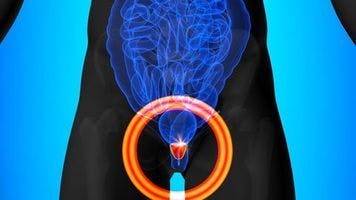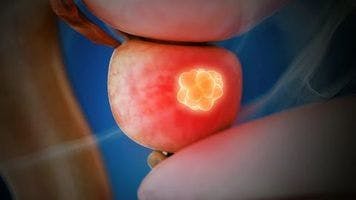Publication
Article
Urology Times Journal
Efficacy of drug-coated balloon catheter for BPH sustained at 1-year follow-up
Author(s):
One-year results of the EVEREST-I study showed sustained efficacy and safety with the Optilume drug-coated balloon catheter system in patients with lower urinary tract symptoms (LUTS) related to benign prostatic hyperplasia (BPH), according to findings published online in Prostate Cancer and Prostatic Diseases.1
At the cutoff date for the data analysis, 75 men had completed 1 year of follow-up. At 1 year, the percent of patients with an improvement of ≥40% in International Prostate Symptom Score (IPSS) from baseline was 81%. This rate was identical to the rate achieved at the 3-month mark, which was the primary end point of the study.
“Treatment with the minimally invasive Optilume BPH Catheter System is safe and showed subjective and objective improvements in LUTS. Benefits were rapid and persisted through 1 year. The initial results warrant further evaluation of this therapy as a treatment option for patients with LUTS related to BPH,” principal investigator Steven A. Kaplan, MD, Mount Sinai Health System, and coauthors wrote.
The Optilume system consists of a “a dilation catheter used to exert radial force to dilate the prostatic urethra resulting in a commissurotomy. The distal end of the catheter has a semi-compliant inflatable double lobe balloon that is coated with a proprietary coating containing the active pharmaceutical paclitaxel,” according to ClinicalTrials.gov.2
Overall, the EVEREST-1 Optilume trial enrolled 80 men with BPH across 6 investigational sites in Latin America. The study investigated 3 sizes of the balloon, described as small, medium, and large.
Beyond meeting the primary end point, the results showed that the mean IPSS score was 22.3 at baseline and had improved to 8.3, 8.0, and 7.9 at 3 months, 6 months, and 1-year, respectively. Mean peak flow rate (Qmax) was 10.9 mL/sec at baseline and 18.4 mL/sec at 1 year. Improvements in both IPSS and Qmax were statistically significant.
Analyses performed with men stratified by balloon size showed that the level of symptom improvement and its durability were similar regardless of balloon size. However, maximum symptom relief was achieved by day 30 using the small balloon whereas it took 6 months to achieve maximum symptom relief with the large balloon.
Analyses of improvements in peak flow rate showed that the large balloon was associated with significant improvement within the first 30 days, but there was a slight deterioration in benefit at 1 year. Peak flow rate improvements were relatively smaller using the small and medium balloons, but peak flow still increased to about 17 mL/sec and remained stable throughout the 1-year follow-up.
Safety was favorable and there were no changes in sexual function, according to the investigators. There was only 1 major device/procedure-related adverse event at 3 months, consisting of 1 subject who developed stress urinary incontinence, which resolved at the 30-day follow-up. The investigators noted that, “Post-procedural complications included common urologic events and the rate of complications was significantly impacted by device diameter.”
Regarding quality of life (QoL) , IPSS QoL improved from 4.6 to 1.3 at 1 year.
PINNACLE trial
Building on the success of the EVEREST-I trial, the ongoing randomized PINNACLE trial (NCT04131907)2 is now aiming to confirm the safety and efficacy of the Optilume as a treatment for men with symptomatic BPH.
The prospective, double-blind, randomized PINNACLE trial is now accruing patients with symptomatic BPH at 18 locations in the United States. Kaplan is also the principal investigator on this trial, which has a target enrollment of 162 patients.
PINNACLE is randomizing patients to either Optilume BPH catheter system or a sham device (21 Fr Optilume BPH, prostatic pre-dilation catheter [modified to prevent inflation]). There will also be a 15-patient nonrandomized pharmacokinetics arm of patients who will receive the Optilume BPH catheter system. The primary outcomes measures of the trial are the change in IPSS from baseline to 12-months post-procedure, and the rate of major device-related serious complications.
According to ClinicalTrials.gov, to enrolled on the study patients must have symptomatic BPH and be aged 50 to 80 years; an IPSS ≥13; peak urinary flow rate (Qmax) ≥5 ml/sec and ≤12 ml/sec (with minimum voided volume of ≥ 150 ml); prostate volume 20 to 80 gm as determined by transrectal ultrasound (TRUS); prostatic urethral length ≥ 32 mm as determined by TRUS; and a history of inadequate response, contraindication, or refusal of BPH medical therapy.
The estimated primary completion date of the PINNACLE trial is June 2021 and the estimated final completion date is June 2025.
References
1. Kaplan SA, Pichardo M, Rijo E, et al. One-year outcomes after treatment with a drug-coated balloon catheter system for lower urinary tract symptoms related to benign prostatic hyperplasia [published online ahead of print April 8, 2021]. Prostate Cancer Prostatic Dis. doi: 10.1038/s41391-021-00362-z
2. A Clinical Study to Evaluate the Safety and Efficacy of the Optilume™ BPH Catheter System in Men With Symptomatic BPH (PINNACLE). NIH US National Library of Medicine: ClinicalTrials.gov. Posted October 18, 2019. https://bit.ly/39TXWU0. Accessed April 8, 2021.



























